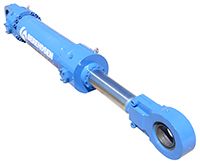In this hydraulic selection guide, we’ll point out the different factors you need to consider in order to select the right hydraulic cylinder for any specific application.
A hydraulic cylinder is a linear actuator engineered to create either a pushing or pulling force in a straight line. It consists essentially of a piston and rod assembly contained within a cylindrical bore which is actuated by the pressure and flow of a hydraulic fluid to produce mechanical force and linear motion.
The proper selection of a hydraulic cylinder requires the consideration of numerous factors influenced by the expected application. Those factors include the amount of force required, cylinder mounting style, stroke length, speed, operating pressure, direction of force, and means of stopping the work load after it is put in motion. Consideration to all these factors is necessary to adequately determine the required cylinder specifications to meet any given application.
Factors to Consider in the Selection of a Hydraulic Cylinder:
1. Mass
The first and most critical step is to determine the amount of mass you wish to move. Once your mass is known, you must then consider the effect that the mass will have on the force required to move it. For example, a 1-ton load being pushed straight up will require just over 1 ton of force, however, a 1-ton load being pushed across the ground will require only enough force to overcome friction and acceleration. Regardless, the force of the cylinder should always be high enough to allow for margin of error.
2. Geometry
Once you know the nature of the mass being moved you then need to consider the geometry involved in moving it. For a machine such as a hydraulic press, which moves typically up and down, the geometry is simple and requires no further consideration. However, when the centre of the load being moved is not centered on the point of lift force and at perpendicular angles to that point of lift force, the force required by the cylinder changes. If you have a crane, for example, the cylinder pushes on the boom often very far from the load. In most cases the load distance (distance from load to fulcrum) can be up to ten times the lift force (distance from lift force to fulcrum), and sometimes more. So the closer your point of lift is to the fulcrum the more force is required by the cylinder to lift the load.
If you don’t know how to perform the calculations specified in this hydraulic selection guide, speak to someone who does. Our dedicated hydraulic engineering team at Berendsen, who assisted in creating this hydraulic selection guide, have the engineering expertise to calculate the required forces for any application.
3. Bore Size
Once you arrive at the force required by your cylinder, the next step is to calculate the bore size required of the cylinder. The force produced by the cylinder is simply the product of the system pressure multiplied by the area of the internal piston surface upon which that pressure acts. This formula is used to calculate the bore size needed to achieve that force.
4. Rod Size
Once a minimum cylinder bore size is determined the next step to the selection of a hydraulic cylinder is to select an appropriate rod size. Most standard off the shelf cylinders usually come with one or two rod options. Selecting the required rod size requires careful consideration of the stroke length required which affects the rod buckling strength. At Berendsen we use programs that calculate whether rod buckling strength for a given rod size and stroke will be suitable for a given load. If you need assistance with this or need a more customised hydraulic selection guide, simply contact us.
In addition to rod buckling, bearing loads is another important consideration in the selection of a hydraulic cylinder. As the stroke length of a cylinder increases, the resultant bearing loads on the piston rod also become greater. To keep these bearing loads from exceeding design limitations stop tubes are usually used. Generally, for applications with strokes greater than 1000 mm, stop tubes are required.
When selecting from standard rod options it is recommended that the smaller rod for a given bore only be used for short stroke push loading or reduced pressure applications, and the larger rod offered be used when wanting to obtain maximum reliability and fatigue life of the rod. However, if it is determined that the required rod diameter exceeds that of the largest available within the selected cylinder bore size, it would then be necessary to reconsider design parameters. Alternatively, it may mean that the application warrants the design of a custom made hydraulic cylinder.
5. Cushions
Once the bore, rod and stroke sizes have been determined another consideration is to whether internal cushions at the end of the cylinder stroke are required. The use of cushions is recommended for deceleration of high speed rods to reduce the energy of the impact of the piston assembly against the cylinder end cap. Cushions are optional and can be supplied at either one or both ends of the cylinder as desired. The use of cushions does not affect cylinder envelope or mounting dimensions.
We hope that this hydraulic selection guide has provided you with the information you need. If you still require additional assistance in the selection of hydraulic cylinders, we would be happy to oblige you. At Berendsen, we have a dedicated hydraulic engineering team that can provide assistance in the selection of Hydraulic cylinders and other hydraulic solutions. Whether it be a cylinder from our standard range or a custom engineered cylinder, we have the expertise to select or design a cylinder to suit any application.



